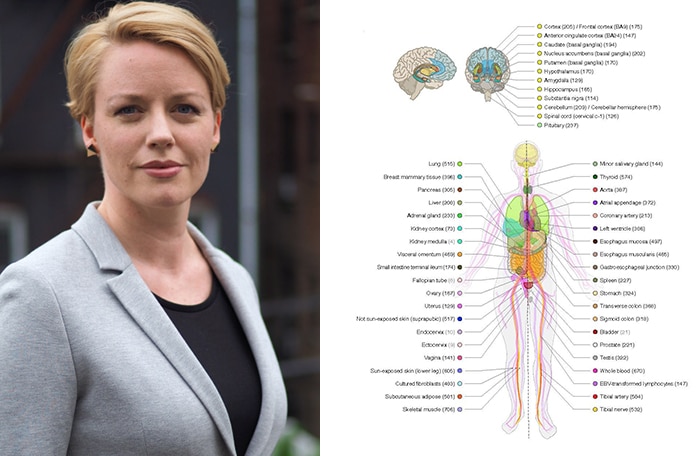Detailing a powerful reference atlas and research tool that catalogs how genetic variants in humans affect gene regulation and contribute to disease risk
The multi-institutional Genotype-Tissue Expression (GTEx) Consortium, in a final-phase initiative co-led by Tuuli Lappalainen, PhD, Core Faculty Member at the New York Genome Center, has published its final set of studies. The new research presents a comprehensive atlas that maps how genetic variants affect gene regulation and how these cellular changes contribute to genetic risk for both common and rare diseases and traits. The set of 15 papers, the culmination of a 10-year effort funded by the National Institutes of Health, were published today in Science and other journals.
Dr. Lappalainen, who holds a joint appointment as Associate Professor in the Department of Systems Biology at Columbia University, is the last author of the main paper published in Science, which completes the GTEx project’s work following earlier-stage analyses published in 2015 and 2017. In the new paper, the GTEx Consortium provides a deep survey into tens of thousands of regulatory variants, based on the GTEx version 8 dataset, which includes 15,201 RNA-sequencing samples from 49 tissues of 838 post-mortem donors and whole genome sequencing data of each donor. Dr. Lappalainen co-led the work with François Aguet, PhD, and Kristin Ardlie, PhD, from the Broad Institute of MIT and Harvard.
Most genetic variants that affect risk for common diseases are located in genomic regions outside the actual genes. It has long been hypothesized that these variants must affect disease risk by affecting how genes are regulated – for example, how much a given gene is expressed in a given tissue – but this relationship has been difficult to unravel. The GTEx resource provides an important tool to address this question.
“This study is a crowning collaborative achievement, in which dozens of scientists combined their expertise to build a map of genetic regulatory variation and to understand the core biology of genetic variation,” said Dr. Lappalainen. “GTEx resources also empower other studies by the genomics community, including disease-specific research, the identification of targets for drug development, and understanding genome function.”
A key methodology used in the team’s report was expression quantitative trait locus (eQTL) analysis to identify genetic variants that affect gene expression, i.e., the regulatory activity of a gene. In parallel, the team also mapped splicing QTLs for genetic variants that affect how RNA is spliced to different versions of the same gene product. Their analysis discovered eQTLs and sQTLs for the vast majority of genes in the human genome across the 49 tissues, making this the most comprehensive catalog of functional genetic associations to date. Through the integration of GTEx data with large-scale genome-wide association studies for diseases and other traits, the team further detailed the mechanisms of how genetic effects from coding and non-coding regions affect gene expression and splicing regulation acts as a driver for disease.
Dr. Lappalainen’s lab team from the New York Genome Center also contributed to several other companion studies of the GTEx Consortium’s set of final papers. A companion paper also published in Science, led by Sarah Kim-Hellmuth, MD, PhD, a former Postdoctoral Fellow in the Lappalainen lab, together with Dr. Aguet and Dr. Ardlie, reports on the project that computationally dissected the gene expression of cell types that are found within the GTEx tissues. While analysis of gene expression of specific cell types has recently become common, most studies only cover a few individuals, or a single tissue. “Our approach allowed mapping genetic variants that affect gene regulation in different cell types for a large number of tissues. This enables better discovery of mechanisms behind genetic variants that affect disease risk,” said Dr. Kim-Hellmuth. Another paper, published in Genome Medicine and led by Margot Brandt, PhD, a former student in the lab, describes the development and application of an experimental method using CRISPR genome-engineering technology to analyze regulatory variants from GTEx and rare disease patients. The third paper, published in Genome Biology and led by Stephane Castel, PhD, a former Postdoctoral Fellow in the lab, describes the GTEx allele-specific expression resource. The Lappalainen lab members also contributed to GTEx papers on sex-specific effects on gene regulation and rare genetic variants.
About the New York Genome Center
The New York Genome Center (NYGC) is an independent, nonprofit academic research institution focused on furthering genomic research that leads to scientific advances and new insights and therapies for patients with neurodegenerative disease, neuropsychiatric disease, and cancer. Leveraging our strengths in whole genome sequencing, genomic analysis, and development of new genomic tools, the NYGC serves as a nexus for collaboration in disease-focused genomic research for the New York medical and academic communities and beyond.
NYGC harnesses the expertise and builds on the combined strengths of our faculty, staff scientists, member institutions, scientific working groups, affiliate members, and industry partners to advance genomic discovery. Central to our scientific mission is an outstanding faculty who lead independent research labs based at the NYGC, and hold joint tenure-track appointments with one of our member institutions.
Institutional founding members of the NYGC are: Cold Spring Harbor Laboratory, Columbia University, Albert Einstein College of Medicine, The Jackson Laboratory, Memorial Sloan Kettering Cancer Center, Icahn School of Medicine at Mount Sinai, New York-Presbyterian Hospital, New York University, Northwell Health, The Rockefeller University, Stony Brook University, and Weill Cornell Medicine. Institutional associate members are: American Museum of Natural History, Georgetown Lombardi Comprehensive Cancer Center, Hackensack Meridian Health, Hospital for Special Surgery, The New York Stem Cell Foundation, Princeton University, Roswell Park Cancer Institute, and Rutgers Cancer Institute of New Jersey.
For more information on the NYGC, please visit: nygenome.org.
